Exploring Crystal Rocks: A Detailed Discovery Guide
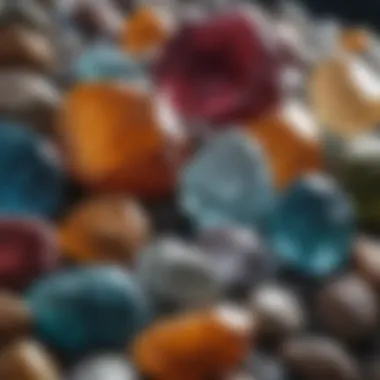

Intro
Exploring the world of crystal rocks is no small feat; it’s a journey filled with both excitement and challenges. Finding these natural wonders is not simply about chance. It requires knowledge, skill, and a hint of intuition. Every collector, whether a novice or a seasoned enthusiast, has their own tale, laced with moments of joy and frustration, as they sift through dirt and stone to uncover these sparkling gems. The pursuit of crystal rocks can deepen your connection with nature while expanding your understanding of geological processes.
In this guide, we will traverse the multifaceted landscape of crystal rock collection, covering everything from identification to preservation. You’ll uncover the rich cultural histories these stones carry, gaining insight into their significance through the ages. By the end, you’ll be better equipped, not only to find crystal rocks but also to appreciate their astonishing beauty and historical importance.
Featured Collectible of the Month
Overview
This month, our featured collectible is the Amethyst. This striking purple quartz is cherished for its unique color and properties. Often found in geodes, amethyst can form spectacular clusters that draw the eye and spirit alike. Amethyst is frequently used in jewelry and decor, making it a sought-after find among collectors and artisans. Its colors range from delicate lilac to deep violet, further enhancing its allure.
Historical Significance
Throughout history, amethyst has held a place of prominence in various cultures. Ancient Egyptians believed it had protective qualities, and in medieval Europe, it was considered a crystal of sobriety, used by monks to avoid intoxication. Its ties to spirituality are still prevalent today, often associated with calmness and balance. This depth of history only enhances its desirability among collectors.
"Collecting crystals is not just a hobby; it's a way to connect with the past, a tangible link between ourselves and the earth's untold stories."
Identification Techniques
Identifying crystal rocks requires keen observation and a few handy techniques to ensure accuracy. It’s essential to know that not all crystals are created equal; each has its unique fingerprints.
Visual Characteristics
Here are some key visual cues when identifying crystal rocks:
- Color: The hue can provide important clues about the type of crystal.
- Clarity and Transparency: Some crystals are translucent or opaque, while others boast remarkable clarity.
- Shape: Observing the natural formations can aid in identification; many crystals have specific shapes—like points or cubical structures.
- Luster: The shininess of the crystal also varies, indicating purity and composition.
Resources for Identification
As you advance in your collection, many resources can assist with crystal identification:
- Books: Texts like "The Crystal Bible" offer detailed descriptions and images.
- Online Platforms: Websites like Wikipedia and Britannica provide extensive information.
- Communities: Forums on platforms like Reddit allow collectors to share experiences and information.
Taking these methods to heart, you will improve your ability to identify crystal rocks and appreciate their stunning complexity.
Foreword to Crystal Rocks
The exploration of crystal rocks intertwines a blend of science, art, and adventure. For many, the allure of these natural formations is not simply in their aesthetic beauty, but in the stories they tell about the Earth's history. Understanding crystal rocks gives collectors a window into geological processes spanning millions of years. They serve as reminders of the dynamic forces that shape our planet, making them not just collectibles, but treasures of knowledge.
When it comes to collecting, knowing what you're looking at is half the battle. By honing in on the nuances of crystal rocks, collectors can not only refine their selection but also appreciate the varied contexts from which these gems emerge. This knowledge can save enthusiasts from unknowingly acquiring fakes or low-quality specimens, elevating the overall collecting experience.
Many collectors might fall into the trap of thinking that all crystal rocks are simply shiny or pretty, but as we’ll delve deeper, there's a richness in understanding their origins, structures, and the minerals that make up their composition.
"The beauty of crystal rocks lies not just in their appearance but in their story—layers of time encapsulated in their formations."
From enhancing personal spaces to grounding healing practices, crystal rocks hold various meanings in today’s society. Thus, they foray beyond mere decoration or scientific interest, engaging with cultural beliefs and modern uses. In this section, we’ll lay down the foundation for what crystal rocks truly are, their significance, and what it means to be a collector in this vast field.
Understanding What Crystal Rocks Are
Crystal rocks, at their core, are naturally occurring minerals that have formed through geological processes. These rocks can come in numerous forms, boasting a range of colors and structures. They're often found in groups known as crystal systems, categorized based on their internal geometric arrangements. Common systems include:
- Cubic: Where the crystal forms are symmetrical, like fluorite and diamonds.
- Hexagonal: Including crystals like quartz and beryl.
- Tetragonal: Found in crystals like zircon.
Each variety presents distinct characteristics and offers different insights into the geological environments they hail from. Some crystal rocks, like amethyst, have a vibrant purple hue, while others like citrine showcase sunny yellows. It’s fascinating how even the slightest variations in temperature and chemical composition can lead to different colors and structures.
Furthermore, beyond their aesthetic appeal, many believe that these rocks possess unique energies. Various spiritual and holistic practices attribute properties to different types of crystals, suggesting they can enhance healing, meditation, or even bring luck. Collectors often find joy in not only the hunt but also in understanding the properties of what they collect.
Ultimately, knowing what crystal rocks are opens up a world of possibilities. Whether it’s embarking on a hike to discover them in their natural habitats, curating a display, or engaging in deeper studies on their properties, these rocks are more than just pretty objects—they're a gateway into earth science, history, and personal exploration.
Geological Background
Understanding the geological background is essential when it comes to finding crystal rocks. This field provides insights into how these beautiful formations come to be, and why specific areas are hotspots for crystal discovery.
Formation of Crystal Rocks
Crystals are like nature’s artwork, each unique and shaped by a variety of geological processes. There are several ways in which crystals can form. One primary method is through the cooling and solidification of magma. When magma cools slowly beneath the Earth's surface, there’s enough time for crystals to develop in a well-structured manner, resulting in larger, more dazzling specimens.
Another pathway involves the evaporation of mineral-rich water. As the water evaporates, minerals crystallize, often leaving behind beautiful formations like rock salt. This happens in places such as dry lake beds or salt flats, where the environment is right for these processes to take place. Additionally, the metamorphosis of existing rocks under high pressure and temperature contributes to the creation of new crystals.
To put it simply, the formation of crystal rocks is mainly influenced by:
- Environmental conditions: Temperature and pressure play huge roles.
- Chemical composition: The minerals present can create various crystal types.
- Time: Crystals need time to grow and structure properly.
"The Earth’s crust is a treasure trove waiting to be discovered; it’s just a matter of knowing where to look and how to interpret the signs."
Types of Rock Formations
Crystal rocks are found in a variety of geological formations, each with its own characteristics and charm. The most common types include:
- Igneous Rocks: Formed from cooled magma, they often contain large crystals. Examples include granite and diorite, which may hide quartz and feldspar crystals within their structure.
- Sedimentary Rocks: Created from accumulated sediments, these rocks can also host crystals, particularly those formed from evaporated minerals like water in salt deposits.
- Metamorphic Rocks: These rocks arise from the transformation of existing rocks caused by intense heat and pressure, resulting in beautiful and intricate crystal formations such as garnet or micas in schist.
Each type of formation plays a vital role in understanding where to search for crystal rocks. Knowing the geological background can make all the difference when it comes down to locating and successfully collecting these natural gems.
Identification Techniques
Identifying crystal rocks is fundamental to successful collection. It’s not just about grabbing pretty stones; it’s about understanding their unique characteristics, which can significantly elevate your collection game. By honing identification techniques, collectors can distinguish between similar-looking minerals and recognize those prized gems that may hold specific geological or even personal significance.
Learning to identify crystals can also save novices from purchasing fakes or low-quality pieces. Proper identification bridges the gap between amateur enthusiasts and seasoned collectors, leading to more informed decisions and a deeper appreciation of the craft.
Visual Characteristics


Visual characteristics serve as the first line of defense in identifying crystal rocks. Color, luster, transparency, and shape all play significant roles in distinguishing one rock from another. For instance, a clear quartz can often be mistaken for other clear minerals, but its hexagonal shape and specific internal flaws can set it apart.
Key points of note when it comes to visual characteristics:
- Color: This can vary widely due to impurities. Understanding the color spectrum of each crystal can help in identification.
- Luster: Crystals can be glassy, metallic, or dull, and each type provides clues about the mineral's composition.
- Shape: The formation of the crystal—whether it’s a single crystal or in clusters—can help you classify it.
Familiarizing yourself with these visual traits is essential for any collector hoping to make informed decisions about their finds.
Utilizing Tools for Identification
To improve accuracy in identifying crystal rocks, employing various tools can be vastly beneficial. They enable you to delve deeper than just what meets the eye, and can be critical in confirming your findings. Here are some popular tools:
Magnifying Glass
A magnifying glass is perhaps one of the most accessible and effective tools. Its simplicity is its charm—you can carry it in your pocket and whip it out anytime a crystal captures your attention. The main advantage of using a magnifying glass is that it allows you to inspect minute details like surface textures or inclusions.
However, it does come with some downsides. Using it in bright light can cause glare, and it might not magnify as well as some handheld jeweler’s loupes. But for the casual collector or the beginner, it’s a solid choice.
Field Guidebooks
Field guidebooks are treasure troves of information that no collector should overlook. They offer detailed descriptions, photographs, and maps of crystal locations. These books are incredibly handy in the field, helping to confirm your identification by providing immediate comparisons. A strong field guide will typically cover a wide range of regional crystals, enriching your knowledge base.
The downside? Some guidebooks can be overwhelming with information and may not focus on the particular area you’re exploring. It’s smart to pick a book tailored to your locale or the kinds of crystals you wish to collect.
Testing Kits
Testing kits take identification to a new level by providing physical tests for hardness, streak, and even chemical composition. A good kit usually comes with essential tools—a hardness scale and streak plates among them. This can give you precise information about the rock's identity, helping distinguish similar-looking minerals such as calcite and aragonite.
However, they can be complex and not always beginner-friendly. Learning to handle a testing kit properly requires practice, but the payoff in confidence and accuracy is worth it. If you’re serious about your collecting, investing in a testing kit might be a no-brainer.
It's clear that each of these tools contributes to a more educated and successful collection experience. The mix of visual inspection and practical tools creates a layered approach that can unveil the intricacies behind every rock you encounter. By mastering these identification techniques, you'll enhance not just your skills, but also your appreciation for the beauty and complexity of crystal rocks.
The Art of Collecting Crystal Rocks
The quest for crystal rocks is more than just a casual hobby; it’s a delicate balance between art, science, and patience. Understanding the nuances involved in collecting these geological marvels is essential for any enthusiast, whether a newcomer or a seasoned collector. The beauty found within crystal rocks varies from stone to stone, shaped by nature over countless millennia. But it’s not just about snatching a piece of rock from the earth. This section emphasizes how the act of collecting can be approached thoughtfully, ethically, and enjoyably.
Collecting crystal rocks provides a window into Earth’s history and diversity. Each piece tells a story—of formation, transformation, and, in many cases, the human touch involved in its collection. More than just aesthetics, each crystal can enhance emotional well-being or add a distinct flavor to home decor. Thus, this delicate art requires a foundation built on respect—not only for the rocks themselves but also for the environments where they originate.
Choosing Locations for Exploration
Selecting the right locations for finding crystal rocks is paramount. The world is dotted with some prime spots, but not every place is ideal for every collector. Here are several important considerations:
- Geological Survey: Research regions known for crystal formations. For instance, sites like Arkansas in the United States are famous for clear quartz. Each state may offer its own unique variety, from amethyst in Brazil to selenite in New Mexico.
- Local Regulations: Familiarize yourself with local laws regarding rock collecting. Some areas have restrictions or require permits, especially in designated parks or protected lands. Ignoring these rules can not only lead to hefty fines but will also harm the very ecosystems collectors aim to cherish.
- Accessibility: Consider factors like terrain difficulty and seasonal weather conditions. It’s crucial to gear up appropriately and avoid areas that could pose physical risks or be inundated during rains. A comfortable hike yields more joy than a treacherous scramble for rocks, especially when you plan on carrying a backpack full of finds.
Incorporating these factors into your search can yield not just more crystals, but a deeper appreciation of the natural world.
Ethical Collecting Practices
Many enthusiasts overlook the ethical dilemmas that can arise during the hunting of crystal rocks. Responsible collecting is essential, not merely to stay within the law, but to preserve the integrity of nature and the hobby itself.
Here are guidelines to ensure your collecting is both satisfying and respectful:
- Leave No Trace: Adopt the principle of taking only what you need and leaving the rest. Avoid disrupting the surrounding environment; in many cases, it’s an irreplaceable habitat for other species.
- Educate Others: Share knowledge about sustainable practices within your community. Inspire fellow collectors to care for both the rocks they collect and the landscapes they traverse.
- Support Local Collectors: If possible, buy crystals from local vendors rather than digging them out yourself. This keeps the local economy thriving and conserves natural reserves.
"Ethical collection—preserves our rich geological heritage while enriching personal collections. It's a win-win for everyone involved!"
Caring for Your Crystals
When it comes to crystal rocks, one might think the journey ends after the initial collection. However, the reality is far more intricate. Caring for your crystals is not merely a task but rather an essential practice that ensures the longevity and aesthetic appeal of your treasures. Keeping your crystals in optimal condition can have numerous benefits. Proper care can prevent damage, retain the crystals’ energetic qualities, and enhance their visual splendor.
Cleaning Techniques
Crystal rocks naturally attract dirt and grime, given their sometimes delicate structures. Regular cleaning is crucial to maintain their luster and integrity. Here are a couple of effective methods:
- Natural Water Rinse: Soaking your crystals in cool, running water can effectively remove light dirt. Avoid hot water, as it might fracture or dull the surface of some crystals. For stones like amethyst and citrine, a gentle wash with mild soap is suitable.
- Dry Cloth Method: For the crystals that shouldn’t get wet, using a soft, dry cloth to wipe them down is a sensible choice. It is gentle and won’t scratch the surface.
- Salt and Water Scrub: If your crystals have any stubborn spots, mixing water with salt can create a soft, natural scrub. Make sure to rinse the crystal off completely afterward.
Remember that some crystals, like selenite, should never be submerged in water. Each type has its own set of requirements for care, thus making it critical to know your crystal’s specific needs. As an important reminder: Always handle your crystals with care.
"A clean crystal is not just a visual delight; it feels alive, ready to connect with you on a deeper level."
Proper Storage Methods
When it comes to storing crystal rocks, the principle of out of sight but not out of mind applies. Proper storage helps protect your collection from damage, dust, and unintended breakage. Here’s how you can ensure your gems are well looked after:
- Use Soft Pouches: Keep crystals in individual soft pouches to eliminate chances of scratching. Silk or microfiber fabric is a great option.
- Display Cases: If you prefer to show off your collection, opt for display cases that offer protection. Glass cases not only keep the dust off but also add a sophisticated touch to your home décor.
- Avoid Direct Sunlight: Exposure to direct sunlight can fade the colors of certain crystals. Store them in dark areas or wrapped in cloth to prolong their original beauty.
- Organize by Type: Grouping crystals by type or size can help with easy access and keeps your collection organized. That could also help you notice which ones need cleaning!
Cultural and Historical Significance
The exploration of crystal rocks transcends mere collection; it taps into the veins of history and culture that have woven these natural wonders into the fabric of human experience. This section aims to shine a light on the multifaceted roles that crystal rocks have played through the ages, from ancient civilizations to present-day beliefs and practices. By understanding these connections, collectors can appreciate crystals not only for their beauty but also for their deep-rooted significance in various cultural narratives.
Crystals in Ancient Civilizations
Crystals have held a special place in human history, serving as both tools and talismans in ancient cultures across the globe. In many societies, crystals were not just decorative items; they were considered vital for spiritual and physical well-being. For instance, the Egyptians revered lapis lazuli, crafting it into intricate jewelry, believing it offered protection in the afterlife. Furthermore, quartz was utilized to create amulets that accompanied mummification.
Meanwhile, in Ancient China, jade was thought to bestow immortality upon its wearer. The connection between jade and virtues like kindness and wisdom is palpable. The Chinese even constructed entire burial sites adorned with jade artifacts, demonstrating the rock's esteemed status.
"Crystals have always been more than just pretty stones; they are the silent witnesses of civilization's dreams, fears, and beliefs."
Similarly, Native American cultures utilized various crystals in ceremonies, believing they channelled healing energies and connected them with the spirit world. These practices are not relegated to history's pages but have been interwoven into the living traditions of many indigenous peoples today.
Modern Uses and Beliefs
In contemporary society, the fascination with crystals persists, albeit with a more diverse interpretation. Many individuals now incorporate crystals into daily life, embracing their purported metaphysical properties. People might reach for amethyst when seeking tranquility or rose quartz to attract love. These modern practices echo ancient beliefs, creating a bridge that links our past with present practices.
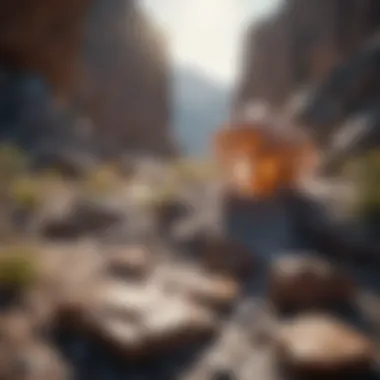
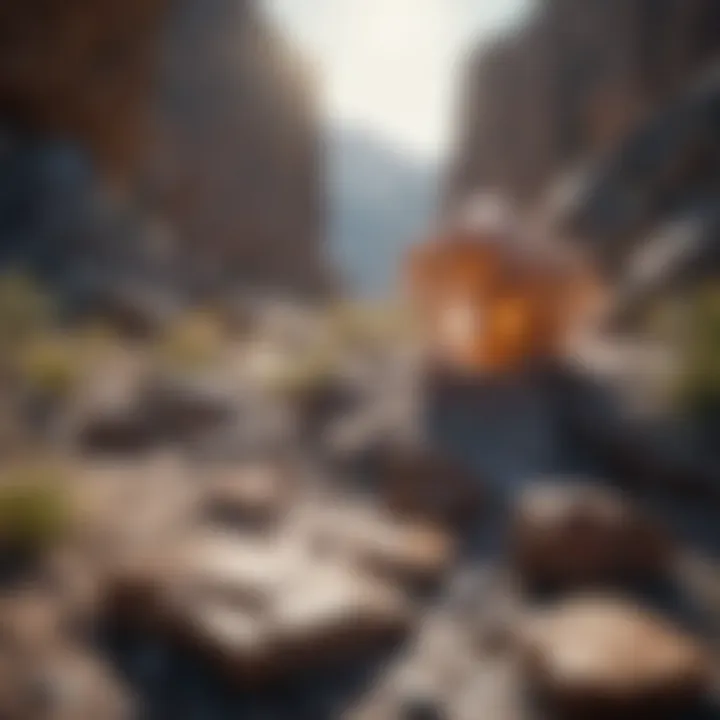
The wellness industry has integrated crystals into holistic healing, suggesting that certain stones emit vibrations that influence energy fields and promote healing. This resurgence in interest can partly be attributed to the broader acceptance of alternative therapies. Crystals, once seen as relics of superstition, are now embraced for their role in mental health and self-care routines.
Moreover, social media plays a critical role in in popularizing crystal culture. Platforms like Instagram and Pinterest showcase beautifully curated crystal collections, allowing enthusiasts to connect and share their experiences. This accessibility has not only democratized crystal knowledge but has also fostered a sense of community among collectors, both novice and seasoned.
As we continue to explore the realms of crystal rocks, it's essential to acknowledge their cultural significance throughout history as well as their modern interpretations. The past and present intermingle, enriching our understanding and appreciation for these remarkable treasures of nature.
Challenges in Crystal Rock Collection
Collecting crystal rocks is not merely a hobby; it’s a blend of passion, patience, and, at times, perseverance. However, to navigate the world of crystal hunting, one must be aware of the various challenges that can arise. These challenges encompass legal concerns and environmental impacts, which are pivotal to fostering a responsible and enjoyable collecting experience. Understanding these elements not only ensures compliance with regulations but also contributes to the sustainability of natural resources for future generations.
Legal Restrictions and Permits
When embarking on a quest for crystal rocks, the first hurdle often appears in the form of legal restrictions. Not every patch of land allows for collection. Regulations can vary significantly from one area to another and knowing where you can dig is crucial. For instance, collecting crystals on private land without permission can lead to legal repercussions; trespassing is no small matter. Many nationalparks have strict guidelines about what can or cannot be collected, often requiring permits.
Some regions may even have specific seasons when collection is permitted. Thus, it’s wise to check local laws and regulations before heading out. Here are some key points to consider:
- Research Local Laws: Start by looking up the laws in regions you plan to explore. Websites of local geological societies often provide this information.
- Obtain Permits: If required, securing the necessary permits is non-negotiable. Some state or federal lands require permits for any form of collection.
- Respect Boundaries: Familiarize yourself with what falls under public versus private land to avoid unintended violations.
"Knowledge is power; understanding the legal landscape protects not only your interests but also the natural world."
Environmental Impact Considerations
Beyond the legal frameworks lies an even more pressing concern – the environmental impact of crystal rock collection. Enthusiasts must recognize that the landscapes we cherish can suffer from exploitation. Over-collection can lead to erosion, loss of habitat, and damage to delicate ecosystems. When collecting, think of the bigger picture and the potential consequences of your actions on the environment.
Consider implementing these best practices:
- Limit Your Collection: Take only what you need. A few specimens are enough to foster your passion without depleting resources.
- Choose Sustainable Locations: Opt for sites where collection is encouraged and monitored to minimize ecological footprints.
- Leave No Trace: Always clean up after yourself. Disturbing the natural environment only increases the risks of long-term damage.
Adopting sustainable habits when collecting can help ensure that crystal rock hunting remains an enjoyable activity for generations to come. The respect shown towards the environment reflects not just on individual collectors but collectively on the community as a whole. Addressing legal and environmental considerations enhances the integrity of the hobby and allows collectors to relish their finds without guilt.
Communities and Resources
In the realm of crystal rock collecting, the importance of communities and resources cannot be understated. These networks provide invaluable support, knowledge sharing, and a sense of belonging among collectors. There’s an undeniable camaraderie that blossoms when individuals passionate about crystal rocks come together. By engaging in these communities, both seasoned collectors and novices can enhance their skills, learn from past experiences, and foster a deeper appreciation for the art of collecting.
Joining Collectors' Societies
Joining a collector's society can be a game-changer for anyone enthralled by crystal rocks. These societies typically offer structured activities that range from field trips to educational seminars. One significant advantage of such memberships is the access to experts. Many societies invite established crystallographers or geologists to speak about recent findings or techniques in identification. This type of exposure can be particularly beneficial to someone just starting out, as it lays a solid foundation in the seminal aspects of crystal collecting.
Moreover, societies often run workshops where members can gain hands-on experience. Participants can bring their collected specimens for expert appraisal, allowing them to gauge the quality and uniqueness of their finds.
In certain cases, being part of a collectors’ society might even grant access to exclusive locations that are not open to the public for rock hunting. This can significantly broaden one’s collection and understanding of various crystal types.
Benefits of Collectors’ Societies
- Networking Opportunities: Meeting people with similar interests can yield friendships and mentorships that last a lifetime.
- Educational Resources: Members frequently receive newsletters or journals that provide updates on geology, particular crystal finds, and more.
- Discounted Events: Many societies offer discounted rates for events that members can attend, further enhancing access to knowledge and collecting opportunities.
Online Forums and Websites
In today’s digital age, online forums and websites abound, providing a platform for crystal rock lovers across the globe to connect, discuss, and share insights. The sheer diversity of these platforms means that anyone can find their niche. Websites like Reddit and Facebook groups function as virtual meeting spots where enthusiasts share photos of their finds, ask for identification help, or discuss collecting techniques.
Engaging in an online forum has its own set of benefits. For one, it allows collectors to access a world of information at their fingertips. Users frequently post tutorials on cleaning techniques or showcase their collections and the stories behind them. Furthermore, having access to an online community means that even those living in remote areas can interact with others who share their passion.
One notable perk of online spaces is the ability to participate in live discussions. Whether it's a scheduled Q&A with a crystal expert or a spontaneous chat about recent discoveries, the fast-paced nature of these platforms means that information can spread like wildfire.
Advantages of Online Forums
- Instant Feedback: If a collector is unsure about the type of crystal they've found, they can post a picture and receive quick feedback.
- Global Interactions: Conversations aren’t limited by geography; discussions can involve people from various countries with different experiences.
- Resources and Links: Members often share articles, research papers, or upcoming events relevant to crystal collection, which can be instrumental in staying informed.
"In the world of crystal collecting, sharing knowledge is akin to finding a gem – it illuminates not just the rocks, but also our understanding of Earth’s wonders."
Overall, communities and resources fundamentally shape the landscape of crystal rock collecting. They transform solitary pursuits into shared adventures, making the journey not only more enjoyable but also more enriching. Whether one finds their friends in local societies or online forums, the connections forged in these spaces create a supportive network for continuous learning and appreciation of crystal rocks.
Spotlight on Unique Crystals
Spotlighting unique crystals in this guide shines a light on both their stunning beauty and geological significance. These rare specimens can captivate both collectors and casual admirers alike. Understanding the importance of unique crystals not only enhances one’s appreciation of these natural wonders but also fosters a deeper connection to the Earth’s geological marvels.
Unique crystals often tell a story; they reveal the environmental conditions and processes that led to their formation, which is critical knowledge for any rock enthusiast. Owning and knowing such pieces isn't merely about possession, it's about engaging with history and nature's artistry.
Rare Varieties and Their Origins
Rare varieties of crystals are like hidden treasures waiting to be discovered. For instance, consider the exquisite benitoite, known for its stunning blue color. This particular gem is primarily found in California. Its presence in the geological record dates back about 50 million years to when the region was formed under high-pressure conditions. With its limited findings and mesmerizing hue, owning a piece of this crystal can feel like having a slice of history in your hand.
Another example is the alluring painite, which was once considered one of the rarest minerals on Earth. Initially discovered in Myanmar, it often gets mistaken for brown zircon due to its color and formation. Its complex crystal structure and rarity often make it a sought-after gem among collectors, reinforcing the thrill of exploration.
When exploring the origins of these unique crystals, collectors should pay particular attention to specific regional characteristics and geological histories. Knowing where to look and what to look for can make all the difference in uncovering these rare gems.
Famous Locations for Crystal Finds
Some locations have earned their reputation as go-to spots for crystal hunters. One such notable area is Arkansas in the United States, famed for its quartz crystals. The Ouachita Mountains are home to numerous mines and extraction sites that yield clear and stunning quartz specimens. Collectors flock here, not only because of the availability but also due to the sheer size and clarity of the crystals found.
Another gem-hunting paradise is Brazil, recognized world-wide for its diverse variety of crystals. From beautiful amethysts to the striking smoky quartz, the mineral-rich landscapes of Brazil offer a feast for the eyes and a challenge for collectors. Particularly, the Amethyst Geode of Uruguay is a sight to behold, featuring massive crystals encased in cavernous rock formations.
Just as important as knowing where to find these unique crystals is being aware of the environmental impact of collecting in these famous locales. Responsible collecting ensures that these areas can continue to be appreciated for generations to come.
"The beauty of unique crystals lies not just in their appearance, but in the stories they tell and the energies they radiate."
Scientific Research and Crystal Rocks
Scientific research surrounding crystal rocks is paramount for enthusiasts and professionals alike. Understanding the science behind these natural wonders not only enriches the collecting experience but also enhances appreciation for their stunning beauty and formation. The convergence of geology, chemistry, and technology sheds light on the intricate tapestry that makes each crystal unique. Research findings can lead to better identification methods and guide collectors in ethical practices, thus preserving the environment and the rocks themselves.
Ongoing Research Projects
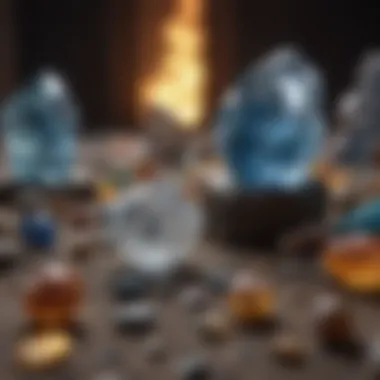
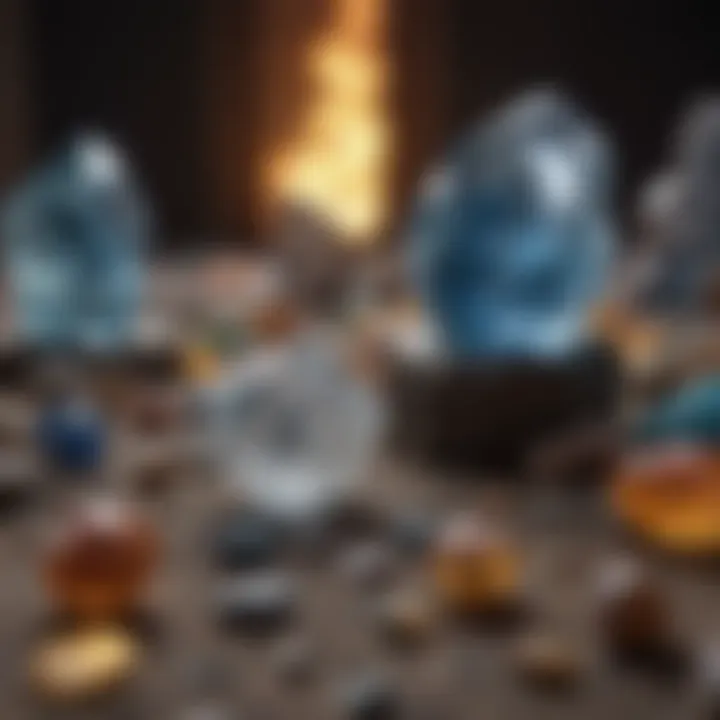
Across the globe, various research projects are probing deeper into the nature of crystal rocks. Scientists are studying the geological processes that lead to crystal formation in different environments, from volcanic regions to sedimentary basins. These investigations often yield insights into:
- Mineral Composition: Analyzing the minerals present gives clues about the conditions under which the crystals formed.
- Crystal Growth Patterns: Understanding how crystals grow can reveal information about their age and history.
- Technological Advances: Some projects focus on utilizing advanced imaging techniques such as electron microscopy and X-ray diffraction to map crystal structures in exquisite detail.
For instance, researchers at the University of Geneva are exploring mineral inclusions within quartz crystals, aiming to trace back the environmental changes of the past. This type of research not only contributes to geology but also helps in predicting future changes in our climate.
New Discoveries in Crystallography
Recent breakthroughs in crystallography have unveiled the complexities of crystal structures, leading to significant implications in multiple fields beyond geology. Advances in techniques like synchrotron radiation and neutron scattering have allowed scientists to probe the atomic structure of crystals with unprecedented precision. This has applications in:
- Material Science: Understanding crystal structures can lead to the development of stronger materials for construction and technology.
- Medicine: New discoveries are aiding in drug development, providing insights into how certain crystal forms can affect the efficacy of pharmaceutical compounds.
- Nanotechnology: Crystal manipulation at the nano-level is paving the way for innovative products like more efficient solar cells.
"The study of crystallography has not only revealed the fundamental properties of crystals but has also painted a broader picture of forces at play in our environment."
Through rigorous research, the passion for crystal rocks transcends simple collection. It evolves into a nuanced journey of understanding nature's handiwork, driving both appreciation and responsibility among collectors. By staying informed about ongoing research and embracing new discoveries, collectors can contribute to a significant legacy of knowledge and conservation throughout their practices.
Personal Experiences and Testimonials
Gathering stories from the field offers a treasure trove of insights that can only be acquired through first-hand experiences. The section on Personal Experiences and Testimonials in this guide serves as a vital piece of the puzzle. It highlights how the journey of each crystal hunter is unique and adds another layer of depth to understanding crystal rocks. The reflections of seasoned collectors and new enthusiasts alike not only create a sense of community but also provide practical wisdom gleaned from real-life challenges and successes.
Exploring personal stories ignites curiosity. For example, many collectors recount specific moments when they stumbled upon an unexpected find in a location that seemed ordinary. These moments, often wrapped in serendipity, speak to the adventure crystal hunting offers.
Interviews with Seasoned Collectors
Conducting interviews with seasoned collectors enriches this guide significantly. These experts have often spent years—or even decades—unearthing the secrets of crystal rocks. Their narrative provides invaluable context on techniques, locales, and even the feelings that come with the hunt.
Many seasoned collectors share their thoughts on equipment, revealing insights that aren't always found in manuals. For instance, one seasoned collector suggests using a lightweight hammer and chiseling tool to minimize damage while extracting delicate specimens. This nuanced approach is essential, as it reflects a deeper respect for the earth and its treasures.
Some notable insights include:
- Patience is Key: Collectors emphasize that taking your time can lead to extraordinary finds. From observing the surroundings to understanding rock formations, patience often rewards those who wait.
- Networking: Building relationships with fellow collectors often opens up access to exclusive sites and insider tips that can vastly improve one's collection.
- Documentation: Regularly documenting finds not only preserves the collector's journey but also aids in identifying patterns and variations in crystal formations.
Essays from New Enthusiasts
Conversely, the voices of newcomers bring fresh perspectives and untainted enthusiasm to the narrative. New collectors are often filled with questions, excitement, and sometimes even trepidation. Their essays can reveal the initial challenges they face, and how perseverance can lead to rewarding experiences.
For instance, a new enthusiast might write about their first expedition. They might describe feeling overwhelmed by the vast landscape yet exhilarated by the possibility of discovering beautiful crystals. This captures the essence of what it means to begin a collection—an unpredictable journey full of highs and lows.
Noteworthy elements from these essays include:
- Learning Curve: New collectors often find themselves in a steep learning curve—whether it’s identifying fakes or determining proper storage techniques.
- Recapturing Wonder: The essay might touch on how beginning this journey rekindles a childlike awe, making every find feel like a prize.
- Community Support: Many new collectors highlight the importance of involving themselves in communities, where shared experiences and tips can convert what seems like a daunting process into an accessible adventure.
"Every stone holds a story, and every encounter teaches a lesson. Whether you’re seasoned or just starting, the journey is what truly matters."
Delving into personal experiences and testimonials fosters a richer understanding of crystal rock collecting. It shows that whether one is a seasoned collector with years under their belt or a newbie just starting, there’s a wealth of knowledge and connection waiting to be uncovered.
Future Trends in Crystal Rock Collecting
As our understanding of environmental impacts and technological advancements evolves, crystal rock collecting is being reshaped in meaningful ways. This section delves into the future of this fascinating hobby, touching upon emerging technologies that streamline identification and the significance of sustainable practices in the field. Acknowledging these trends is crucial for both novice and seasoned collectors, as they navigate the changing landscape of crystal rock exploration and appreciation.
Emerging Technologies in Identification
In a world increasingly dominated by technology, the crystal collecting community is not lagging behind. New tools and techniques have emerged to assist collectors in the accurate identification of crystal rocks without the need for extensive prior knowledge.
Innovative Tools
The use of mobile applications designed for mineral identification is becoming more popular. These apps utilize image recognition technology to analyze photographs of crystals, providing immediate feedback on their types. For example, apps like Rock Identifier let users take a picture and get results on their devices, turning the collecting experience into a more engaging and interactive task.
Advanced Equipment
Moreover, some enthusiasts are adopting handheld spectrometers, which can analyze the light spectrum of a crystal, helping to identify its unique properties with remarkable accuracy. With such devices, hobbyists no longer have to second guess whether what they’ve found is quartz or calcite.
"Technology not only enhances knowledge but also enriches the joy of discovery."
These advancements lead to better understanding and greater appreciation of diversity among the rocks, allowing even beginner collectors to feel confident in their findings.
Sustainable Collecting Practices
As the awareness of environmental conservation rises, collectors are beginning to consider the implications of their hobbies on local ecosystems. Collecting crystal rocks isn't merely about the thrill of the chase; it now comes with a responsibility to the earth.
Responsible Sourcing
One of the most pressing trends is the emphasis on ethical and sustainable sourcing of crystal specimens. This means avoiding locations where mining practices cause significant ecological damage. Collectors should prioritize sourcing crystals from regions that adhere to environmentally friendly extraction methods. For example, purchasing from local artisans who have responsibly mined minerals can greatly reduce the ecological footprint.
Awareness and Education
Community efforts are underway to educate collectors about the importance of sustainable practices. Workshops and seminars, often hosted by crystal societies and local rock hounding groups, focus on proper techniques to minimize the impact on habitats and to respect legal boundaries surrounding collecting.
Finally, as the trend toward sustainability continues, collectors should also be aware of the growing market for synthetic crystals and how these can serve as alternatives that do not harm the earth.
In essence, the future of crystal rock collecting is becoming more integrated with modern technology and conscious of the environmental sustainability of the practice. By staying informed about these trends, collectors can ensure that their passion not only brings them joy but also contributes positively to the world around them.
Epilogue and Final Thoughts
The journey of discovering and collecting crystal rocks isn’t just a hobby; it’s an intricate dance with nature’s creativity. Throughout this article, we explored various aspects that contribute to the fascinating pursuit of these geological gems. From geological formations to identifying techniques and ethical collecting practices, every piece of information contributes to a more profound understanding and appreciation of crystal rocks.
The Importance of Embracing Crystal Rocks
In a time when technology is so pervasive, getting out into the wild to hunt for crystal rocks is like a breath of fresh air. It fosters not only a connection with the earth but also supports mental well-being. As collectors delve into the mystery of these rocks, they forge a bond with the ancient history encapsulated within each specimen. Such pursuits offer joy and fulfillment, allowing collectors to create a personal narrative from their finds.
"Every rock tells a story; it’s up to us to listen carefully."
Moreover, understanding the cultural and historical significance of crystals enhances their allure. Crystal rocks have been treasured for medicinal uses, religious ceremonies, and even artistic endeavours throughout human history. This knowledge fosters a greater respect and responsibility towards these natural wonders, emphasizing the need for ethical practices in collection to ensure their survival for future generations.
Key Benefits of Collecting Crystal Rocks
- Educational Insight: Engaging with crystal rocks educates collectors about geology, mineralogy, and even metaphysics.
- Community Connection: Joining collectors’ societies and online forums allows enthusiasts to share experiences and exchange knowledge, nurturing a sense of belonging.
- Personal Growth: Each find, whether a well-known crystal or a hidden gem, serves as a motivator, pushing collectors to explore further and learn more.
In wrapping up, the allure of crystal rocks transcends mere collection. It’s a holistic experience involving exploration, education, and connectivity. As we continue to delve into our planet's treasures, may we do so with a spirit of curiosity and respect, ensuring that we not only enjoy these magnificent artifacts but also protect them for those who will come after us.



